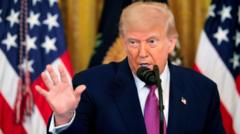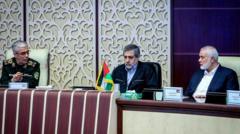**This article explores the context and implications surrounding the US operations, Iran's potential response, and the ongoing geopolitical dynamics.**
**Escalation in Middle East: US Military Strikes on Iran's Nuclear Sites**

**Escalation in Middle East: US Military Strikes on Iran's Nuclear Sites**
**In a significant development, the US has launched military strikes on three key Iranian nuclear facilities, escalating tensions in the region.**
The United States has conducted military strikes on three Iranian nuclear facilities, as confirmed by President Donald Trump in a social media post. This military action marks a considerable escalation of the ongoing conflict involving Iran and Israel, with Trump stating, "We have completed our very successful attack on the three Nuclear sites in Iran, including Fordow, Natanz, and Esfahan," emphasizing that all US military aircraft are now outside of Iranian airspace. Notably, the Fordow facility is an underground uranium enrichment site crucial to Iran’s nuclear aspirations.
The strikes occurred amidst a backdrop of escalating hostilities, which began with Israel's surprise attack on Iranian military and nuclear targets on June 13. Israeli Prime Minister Benjamin Netanyahu asserted that the objective was to dismantle Iran’s nuclear program, which he claimed was on the verge of being weaponized. Iran, asserting that its nuclear pursuits are peaceful, subsequently launched a barrage of rockets and drones towards Israel, leading to an ongoing exchange of aerial attacks.
Despite Trump’s vocal opposition to Iran’s nuclear ambitions and previous comments about America’s involvement in Middle Eastern conflicts, the swift military action surprised many, as it came shortly after he had announced a temporary pause to allow for diplomatic negotiations.
The airstrikes utilized the GBU-57 Massive Ordnance Penetrator (MOP), designed to penetrate deeply buried targets, making it effective against sites like Fordow, which experts believe is located well below the Earth’s surface. Although the full extent of the damage incurred at the nuclear sites remains unclear, Iranian officials claim that significant precautions had been taken, suggesting that materials were evacuated prior to the attacks.
Iran has threatened retaliation, warning the US that its involvement could lead to “irreparable damage” and a wider regional conflict. They have signaled intentions to target US military bases scattered throughout the Middle East and may disrupt critical shipping routes such as the Strait of Hormuz.
Under US law, while the President has the authority as Commander in Chief to deploy troops and conduct military operations, formal declarations of war require Congressional approval. Although some lawmakers are attempting to push back against Trump's ability to unilaterally escalate military actions, such efforts may take considerable time and could ultimately be more symbolic than influential.
As the situation develops, experts warn that Iran's capabilities should not be underestimated, even as it faces pressure from multiple fronts, potentially leading to increased instability in the region.
The strikes occurred amidst a backdrop of escalating hostilities, which began with Israel's surprise attack on Iranian military and nuclear targets on June 13. Israeli Prime Minister Benjamin Netanyahu asserted that the objective was to dismantle Iran’s nuclear program, which he claimed was on the verge of being weaponized. Iran, asserting that its nuclear pursuits are peaceful, subsequently launched a barrage of rockets and drones towards Israel, leading to an ongoing exchange of aerial attacks.
Despite Trump’s vocal opposition to Iran’s nuclear ambitions and previous comments about America’s involvement in Middle Eastern conflicts, the swift military action surprised many, as it came shortly after he had announced a temporary pause to allow for diplomatic negotiations.
The airstrikes utilized the GBU-57 Massive Ordnance Penetrator (MOP), designed to penetrate deeply buried targets, making it effective against sites like Fordow, which experts believe is located well below the Earth’s surface. Although the full extent of the damage incurred at the nuclear sites remains unclear, Iranian officials claim that significant precautions had been taken, suggesting that materials were evacuated prior to the attacks.
Iran has threatened retaliation, warning the US that its involvement could lead to “irreparable damage” and a wider regional conflict. They have signaled intentions to target US military bases scattered throughout the Middle East and may disrupt critical shipping routes such as the Strait of Hormuz.
Under US law, while the President has the authority as Commander in Chief to deploy troops and conduct military operations, formal declarations of war require Congressional approval. Although some lawmakers are attempting to push back against Trump's ability to unilaterally escalate military actions, such efforts may take considerable time and could ultimately be more symbolic than influential.
As the situation develops, experts warn that Iran's capabilities should not be underestimated, even as it faces pressure from multiple fronts, potentially leading to increased instability in the region.























